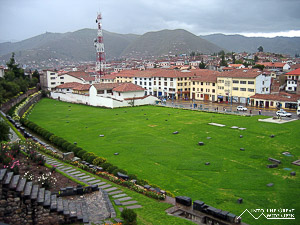Cusco, Peru
Cusco and the Sacred Valley
February 20, 2008
Every thought is undermined
By all the history inside
- Staind

My first impressions of Cuzco, after walking around the main plaza and the central area, was what a hassle it was to move around and accomplish anything. Every step you take you are constantly hounded by people trying to sell you things, from postcards, paintings, sweaters, and tours, to massages and meals in restaurants. There is one alley, known as gringo alley, where the restaurant promoters compete voraciously to get you inside their restaurant. If one offers free nachos the other offers free nachos and garlic bread, and then another offers those plus free drinks, and then the other counters with talk of a fireplace, it just goes on and on. Then there are the guys trying to sell you drugs of all sorts, quite openly as the police walk the main plaza at the end of the alley. The large number of tour companies is also simply amazing.

After talking with many of the tour companies I came to learn that most of them work together to form groups of people for the various tours, they communicate over the phone and via instant messenger networks over the Internet. It becomes confusing because not all of them work together and they will never tell you which companies they work with. This becomes very frustrating when you are walking around and trying to compare the different prices and tour operators because you always hear something different. In the end, the hike that I wanted to do, from Choquequirao to Machu Picchu, wasn´t possible because no one else was interested in the same route and there was a minimum group size that was needed.
Being February the Inca Trail was closed so I settled for visiting Machu Picchu on my own, but that was easier said than done. I had arrived in Cuzco on Sunday and there was much talk of the strike that was supposed to happen all week. The strike was over the government´s talks about privatizing the operation of many of the tourist sites and ruins around Peru in order to further develop them for tourism. The people of Cuzco are opposed to this for many reasons and had decided to show the government their disapproval. On Monday protesters stopped the trains from Cuzco to Machu Picchu, but otherwise transportation was running as normal through Wednesday, although there was much uncertainty over whether there would be transport on any given day.

On Tuesday I took a day tour to the Sacred Valley, solely for the convenience it provided in terms of transportation. We left at 6:30am because the tour operator thought the road would be blocked by the strikes later in the morning. We first visited Pisac where there is a large fortress and some religious buildings on the mountain overlooking the town. Unfortunately, the tour only visited one part of the site, leaving the other and more interesting part untouched. From there we proceeded to an overpriced lunch at a touristy restaurant on the way to Ollantaytambo where there are some very nice ruins of temples, terraces, and dwellings set into a hillside near the town. The town itself is very nice with old Inca streets complete with water canals and newer buildings built on top of the original Inca foundations. Across the valley from the main site of ruins there is another small set of ruins way up on the mountain. This part is very picturesque and is actually free to visit. There is a steep trail leading up there from a street in the town and if you can climb up to the ruins you will almost certainly be there on your own.
Past the highest part of the ruins there is even a cave that proceeds for quite a ways into the mountain, gradually narrowing and was probably used by the Incas for storage. The highest and seemingly more interesting parts of the main ruins in Ollantaytambo are off-limits for whatever reason. Leaving Ollantaytambo we proceeded to Chincherro where this is an amazing church built on top of an Inca temple. The inside of the church has intricately painted wooden ceilings and walls and an immense amount of character and atmosphere to it; sadly it was prohibited to take pictures inside. After Chincherro we returned to Cusco without any incident or delay from the strikes.

With no plans for hiking I set out for the train station to get tickets to Aguas Caliente, the village at the base of Machu Picchu. I was able to buy a ticket there for Wednesday night but they would not sell me a return ticket for Friday because they said there would be a strike on Thursday and Friday and thus no transportation anywhere. As a backup plan I bought a return ticket for Saturday, hoping that I might be able to change it in case trains were running on Friday. In the worst case I would be stuck in Machu Picchu until Saturday morning, hopefully not longer but I guess it would not be a bad place to be stuck.








































































